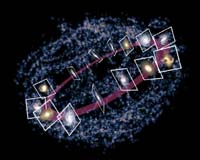| . |  |
. |
Pasadena CA (JPL) Mar 19, 2010 Planck's ability to measure the temperature of the coldest dust particles will provide a better understanding of the physical processes at play in the spaces between stars, and in regions of star formation. This image covers a portion of the sky about 50 degrees in total extent. It is a three-color combination constructed from Planck's two highest frequency channels (557 and 857 Gigahertz, corresponding to wavelengths of 540 and 350 micrometers), and an image obtained at 100 micrometers with the Infrared Astronomical Satellite (IRAS). This combination effectively traces the dust: reddish tones correspond to temperatures as cold as 12 degrees above absolute zero, and whitish tones to significantly warmer ones (on order a few tens of degrees) in regions where massive stars are currently forming. Overall, the image shows local dust structures within 500 light-years of the sun. This Planck image was obtained during the first Planck all-sky survey, which began in mid-August 2009. By mid-March 2010, more than 98 percent of the sky had been observed. The second sky scan is underway, but, because of the way Planck surveys the sky, the first scan won't be 100 percent complete until late-May 2010. Planck is a European Space Agency mission, with significant participation from NASA. NASA's Planck Project Office is based at JPL. JPL contributed mission-enabling technology for both of Planck's science instruments. European, Canadian, U.S. and NASA Planck scientists will work together to analyze the Planck data.
Share This Article With Planet Earth
Related Links Planck at ESA Stellar Chemistry, The Universe And All Within It
 Seeking Dark Matter On A Desktop
Seeking Dark Matter On A DesktopMenlo Park, CA (SPX) Mar 16, 2010 Desktop experiments could point the way to dark matter discovery, complementing grand astronomical searches and deep underground observations. According to recent theoretical results, small blocks of matter on a tabletop could reveal elusive properties of the as-yet-unidentified dark matter particles that make up a quarter of the universe, potentially making future large-scale searches easier. ... read more |
|
| The content herein, unless otherwise known to be public domain, are Copyright 1995-2010 - SpaceDaily. AFP and UPI Wire Stories are copyright Agence France-Presse and United Press International. ESA Portal Reports are copyright European Space Agency. All NASA sourced material is public domain. Additional copyrights may apply in whole or part to other bona fide parties. Advertising does not imply endorsement,agreement or approval of any opinions, statements or information provided by SpaceDaily on any Web page published or hosted by SpaceDaily. Privacy Statement |